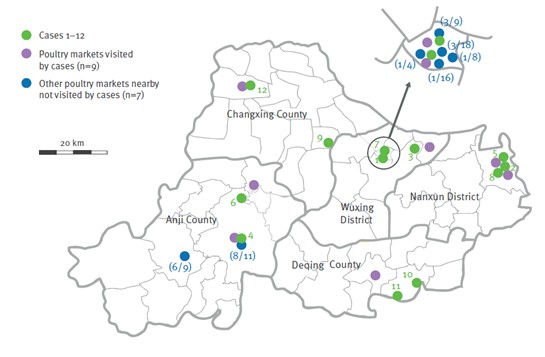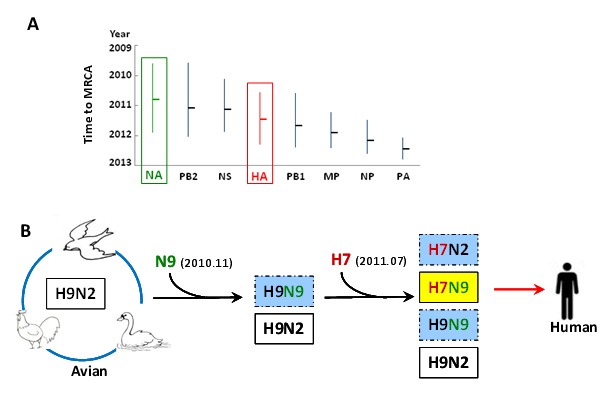On March 12, the Journal of Virology published online an article entitled “Co-circulation of three HA and two NA subtypes of avian influenza viruses in Huzhou, China, April 2013: implication for the origin of the novel H7N9 virus”. The research was accomplished by researchers at Institut Pasteur of Shanghai (IPS), Chinese Academy of Sciences and Huzhou Center for Disease Control and Prevention (Huzhou CDC), Zhejiang Province.
Since February 2013, a novel H7N9 avian influenza virus (AIV) has led to an outbreak of human infection in Yangtze River Delta Region of China. Huzhou is located in the geographic center of Yangtze River Delta (Fig. 1), one of the worst-hit areas of the H7N9 outbreak. According to the statistics released by the National Health and Family Planning Commission of China, the first confirmed H7N9 case in Huzhou city occurred on April 4, 2013, which was the 10th confirmed case in the nation. Based on the cooperation agreement between IPS and Huzhou CDC, an IPS research team including Profs Ke Lan, Qibin Leng, Dongming Zhou, Chiyu Zhang, research specialists Lili Wang and Jia Liu, was set up to investigate the molecular epidemiology of the H7N9 infection.
The temporal dynamic data showed the NA gene of the novel H7N9 strains had an estimated tMRCA (the time to most recent common ancestor) earlier than HA genes; suggesting the novel H7N9 virus originated from at least two rounds of reassortment events (Fig. 2). The first round of reassortment led to the formation of evolutionary intermediate lineage H9N9 by replacing N2 NA gene of H9N2 virus with N9 NA gene; the novel H7N9 virus originated via the second round of reassortment, during which H7 HA gene was reassorted into the genome of H9N9 virus (Fig. 2). By amplifying the H7N9 sequences from poultry-related samples, the team found co-circulation of three HA and two NA subtypes of avian influenza viruses. A/Chicken/Huzhou/C143/2013(H9N2), which clusters immediate outside of the novel H7N9 clade in the phylogenetic trees of six internal genomic sequences, represents the most similar strain to the parental H9N2 strain involved in the generation of the novel H7N9 virus. In addition, the team found two potential H9N9 reassortants among two poultry-related samples. Huzhou faces the south of Taihu Lake, where locates two natural wetlands inhabiting over 160 kinds of wild birds, and provides a dynamic environment for co-circulation of various AIVs.
This study built on collaborative work between IPS and Huzhou CDC provides valuable information for prevention and control of current H7N9 epidemic. The expertise of IPS was proved as an important role for local administration in prevention and control of infectious diseases.
The team described previously clinical presentation of the first confirmed dead case due to H7N9 infection in Huzhou (Emerg Microbes Infect 2013, 2:e23), investigated the epidemiology of confirmed H7N9 cases and monitored the H7N9 prevalence in live poultry markets from spring to winter, 2013. They found that all H7N9 cases (n=12) in Huzhou had a history of direct exposure to poultry, including some cases who acquired infection due to exposure to free-range poultry. It supported that poultry was the direct animal reservoir (Euro Surveill. 2013; 18(20): pii=20481). By detecting H7N9 RNA with positive rates from 4%-22.2% among poultry samples in targeted markets from August 6 to September 24 2013, the team indicated that the novel H7N9 virus has a better fitness or adaptation to poultry even if under hot weather(Int J Infect Dis, in press).
The researches were supervised by Profs. Ke Lan, Qibin Leng, Dongming Zhou and Chiyu Zhang. This study was supported by the grants from the China National Mega-projects for Infectious Diseases (2012ZX10004211-002 and 2013ZX10004101-005), and the Li Ka-Shing Foundation.
The link for the related articles: J Virol:http://jvi.asm.org/content/early/2014/03/06/JVI.03319-13.abstract
Euro Surveill:http://www.eurosurveillance.org/ViewArticle.aspx?ArticleId=20481
Emerg Microbe Infect:http://www.nature.com/emi/journal/v2/n5/abs/emi201328a.html

Fig.1. Distribution of the influenza A(H7N9) confirmed cases and live poultry markets in Huzhou city, China, March–May 2013

Fig. 2. Temporal dynamics (A) of the novel H7N9 virus and its reassortant model.

